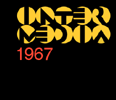public record
<-- previous | next -->
JAMES BARBER SUMS UP
The lessons of Intermedia Nights
When Intermedia Nights at the Vancouver Art Gallery finally closed last Saturday, after the final, quiet, "bring down" by Helen Goodwin and her dance company, which had some 150 people quietly occupying a soft and many dimensioned space of glowing tubes, quiet music and gentle movement, the guard at the door smiled. And he said, "It'll never be the same again."
He wasn't complaining. He was genuinely sorry to see the noise, and unfamiliar faces, and the visitor comments, the two o'clock in the morning closings, and the constantly frantic "we've got a half an hour to do three hours work" Intermedia people depart.
He had seen something different. So had the visitors, and so had the exhibitors. And i think everybody had learned something.
First of all, the Vancouver Art Gallery learned that some 2,000 people had visited the Gallery during the four evenings of Intermedia Nights.
Some of them were Gallery members, but many of the audience went in the same spirit as agnostics attending a Sartre play in an Anglican cathedral. They wanted to see not only what was new, but what the ante-establishment could get away with.
The establishment roll was further emphasized by the current exhibition of Royal Faces, but it was not the establishment's week, a point made even more clearly by the interesting that Intermedia which was to collect all admissions, took less money during it's 600-people Friday than it did on the 200-people Tuesday.
The establishment would at least have organized its admission procedures. but none of this matters. The Gallery learned that , in doing a favor to the Canada Council by providing a space for Intermedia to show the Council what it was getting for it's $40,000, it had done itself a favor by helping to uncover the enormous interest in experimental art work, and a great hunger for participatory art.
The audience learned a number of lessons. Firstly, that without a yardstick of critical they were on their own when it came to making judgments, and that an intense dislike in such an unstructured situation is both valid and instructive.
I know a number of people who, determined to do something better. are doing things in anticipation of the next show - and many of them were made aware, if not of their capability, at least of their imaginations.
They learned, too, of the new and passionate affair between art and technology. But only in the drug store film magazines are affairs accepted as permanent relationships, and only the particularly naive could accept much of what they saw as anything but experimental feelers, and in some cases rather dreary plagiarisms of what was being done years ago by the really avant-guard.
They also learned of their own limitations. In their occasional inability even to consider, let alone relate to, work that was not obviously part of the new order.
Experiments need patients, and an acceptance of unpredictable results if, in the end, some new truth is to be discovered.
And this too, is something which I am sure Intermedia has learned. Most of the people working at the Gallery, were franticly pressured and madly improvising, often with inadequate equipment. And having had one exposure, enormously well publicized and helped along by a great initial curiosity, they should now be acutely aware of the difference between a dream on the Intermedia floor and something offered for public view.
Electronics in art must be almost as foolproof as they are in aircraft, for in both there is frequently only one chance to maintain confidence.
There is nothing more disheartening for a gallery visitor to arrive full of curiosity pay his money, and then find that his artistic experience has the dead look that only a bunch of dangling wires or a blown fuse can produce.
But most of all, I think that this week, has stressed the "inter" part of Intermedia. There has been enormous co-operation' a Great deal of constructive talk and the beginning of a new understanding of the difficulties of discipline in association with others.
This can only lead to more exchange between artists and an acceptance of the discipline involved in co-operation, when egos, which figure very large in original concepts, must be subordinated to the demands of the co-operative venture, if it is to reach the public to which it is shown.
public record
<-- previous | next -->
